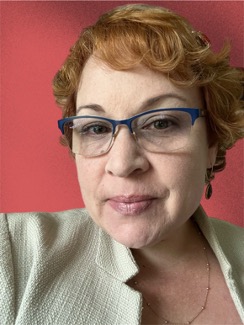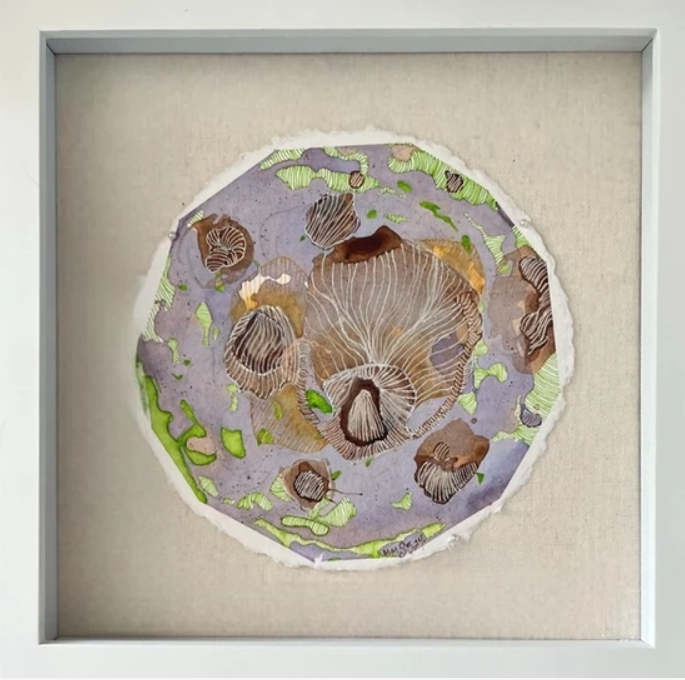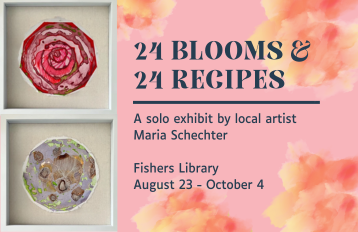The construction finishing up at the Fishers branch of Hamilton East Public Library has given the library and Ignite Studio the space to display artwork inside the newly renovated north entrance. You may have already seen our collaborative exhibit with the Fishers Arts Council for March Disability Awareness Month there, or maybe you have seen the artwork produced during the Fishers Make-Off on display. Now, we also get the opportunity to begin hosting singular artist’s work in that space, starting with artists who have been heavily involved with Ignite Studio and HEPL. This is a chance to show off how talented members of the HEPL community are! Next up in this exciting new program is Maria Schechter.
Maria Schechter is a bio-artist whose work won first place in Ignite Studio’s third annual installment of “The 700 Collection”, a juried exhibit. She is also an active participant at Ignite through teaching – catch one of her botanical dye painting workshops in August! Enjoy her solo exhibit, “24 Blooms & 24 Recipes”, on display near the glass cone inside the north entrance at the Fishers branch from August 23rd – October 4th 2024.
About the Artist

Photo supplied by the artist
Maria Schechter is a bio-artist inspired by Hildegard of Bingen and the natural world. Using foraged botanical palettes informed by the High Middle Ages, she also utilizes mycelium and clay as her primary medium. Schechter shapes her works using living and natural materials. Maria grows her paintings and her sculptures using a mycelium composite as her main medium. Her recent work showcased with the Minnetrista Museum and Gardens in Muncie, IN.
Maria teaches workshops on botanical painting and mycelium as a medium. She lives in Bloomington, IN with her husband and 5 animals.
About the Art
Maria Schechter is inspired by the scribes of the High Middle Ages who worked on illuminated manuscripts. Their work and recipes inspired her to continue her own research after an art and science residency with the Ayatana Biophilium Artists Research Residency in Canada. In 2022, Maria was awarded three international residencies with the Biophilium: “Symbiosis: Science School for Artists,” “Mycophilia: Mushroom School for Artists,” and “Earth Pigments/Wild Craft.”
Schechter is fueled by Hildegard of Bingen’s life and the surroundings of her home in Germany. Hildegard of Bingen was a Christian mystic, the first female composer of the western world, a naturalist, doctor, and excelled in many other areas. She is considered a polymath of the High Middle Ages. Maria was introduced to the work of Hildegard of Bingen in her first year of undergraduate studies with Cornish College of the Arts in Seattle, Washington. During a women’s studies class, Maria learned about “Viriditas,” which was the guiding image for Hildegard and appeared regularly in her work. Viriditas refers to the greening power of nature as a metaphor for physical and spiritual health. Viriditas were, in part, the visible aspect of the lush, greenness of the divine in nature.
The exhibit “24 Blooms” references the healing power of nature and the 24 recipes inspired by High Middle Age scribes who painted the illuminated manuscripts. Many of their palettes were made by processing botanical materials into dyes. Using the same methods of combining salts and metals, she follows the traditional dyer’s method. With continued research at Indiana University’s Lilly Library, Maria developed eco-friendly recipes. Most of these recipes have been made with substantial material such as onion skins, black walnut, and even the skins of pomegranate which are tannin rich mordants that still allow for the color to bite the paper or fabric and give us a healthier recipe for a healthier world. The colors are as rich, vibrant, and lightfast as the traditional materials of using alum and washing soda (metal and salts). The botanical palettes yield the same vibrant colors of the middle ages.
There are 24 blooms in this collection and 24 individual botanical recipes. Most of the botanical materials were sourced in Hamilton County which means those botanical materials were foraged and processed into botanical color palettes.
The 24 blooms highlight 24 hours in a day. Sunlight, as we know, is essential for most blooms with the exception of ghost pipes, which are included in this series. Ghost pipes are completely white, almost transparent. So how do these plants survive without the green pigment chlorophyll? Chlorophyll is responsible for harnessing the sun’s energy to produce carbohydrates, a process known as photosynthesis. The ghost pipe saps nutrients and carbohydrates from tree roots through an intermediate source, myccorhizal fungi. That is unlike any other flower we know.
As there are 24 hours in a day, we all depend on the hours of sunlight. What is the significance of the number 24 found in nature? Have you ever wondered why the petals of a sunflower, the scales of a pineapple, or the spiral of a snail shell follow a certain pattern? The answer is the Fibonacci sequence, a mathematical phenomenon that reveals the beauty and harmony of nature. The Fibonacci sequence has a pattern that repeats every 24 numbers. Next time you are enjoying local flowers be sure to look for the number 24.

“Angel Amber Kiss Pansy”; 12×12; onion skins, avocado, coffee, red cabbage, and green ink on recycled watercolor paper
From the Artist
“Throughout history, artists have directly impacted how the world experiences itself. As a bio artist with ecological principles, I believe we carry a responsibility to our materials in addition to the communities we serve and the narratives we create. The responsibility lives in the art of communication. Although I am not a scientist, I share my research on botanical painting recipes and experiments with processing natural and foraged materials into botanical palettes in my workshops. My focus is also on using mycelium as a medium. My journey of healing has been to understand how our bodies work, so in a sense it’s very much like my goal as an artist to reveal the majesty of the underground, ultimately casting light on what cannot be seen.
The primary goal of ecologists is to improve their understanding of life processes, interactions, and the biodiversity of organisms. As a bio artist, I want to visualize what cannot be seen and share what that means for all of us. I share bits of my research in both my work and my workshops. I have been an artist for over 30 years, and I only entered this space 6 years ago. My thoughts, intentions, and processes live in a space of spirit or energy. I recently shared a bio painting titled The Interior Life of a Mermaid with the Minnetrista Museum and Gardens, part of a larger exhibition titled “Open Space: Art About the Land.” The sculptural pieces of this work were grown from mycelium. The colors used were from Indigo as well as foraged Japanese Maple resin as a highlight in the piece to directly speak to the topic in relation to the land and what trees provide us: food, shelter, medicine, and clean air.
Articulating the experience of working with mycelium is difficult because it’s as close to Spirit as I can get as a human. My painted works are informed by the middle ages. As a creative, I’m most inspired by Hildegard von Bingen. She is also known as Saint Hildegard and the Sibyl of the Rhine. She was a German Benedictine abbess and polymath active as a writer, composer, philosopher, mystic, visionary, and as a medical writer and practitioner during the High Middle Ages. Hildegard spoke often of viriditas, the greening of things from within, analogous to what we now call photosynthesis. She saw that there was a readiness in plants to receive the sun and to transform its light and warmth into energy and life. She recognized that there is an inherent connection between the Divine Presence and the physical world. This Creator-to-created connection translates into inner energy that is the soul and seed of every thing, an inner voice calling us to “become who you are; become all that you are.” This is our life wish or “whole-making instinct.”
She has served as inspiration to me since I was 17 years old and I first learned about her in a women’s studies class during my undergraduate studies. It is a challenge to visually articulate what is not seen. I feel the same about forests, animals, and all sentient beings and our own bodies. It is a challenge to reach into a space few have traveled before. Bio art is my way of combating eco-grief, a term coined by Jane Goodall in her new book “Hope.” As a bio artist, I encourage other artists and my community to innovate with me. If we can overcome eco-grief together by exploring alternative sustainable materials, it is one way we can address our climate crises. My responsibility is to create works that are approachable, engaging, and stimulate innovation and continued stewardship of the natural world.
I use mycelium as a primary medium as well as clay. I found my way to the underground via a scholarship I received from The Fantastic Fungi Global Summit in 2021. An introduction to mycelium should go hand-and-hand with the materials provided to me during the Fantastic Fungi Global Summit. The summit was saturated with authors, leaders, scientists, mycologists, and biologists, such as Paul Stamets, Andrew Weil, and First Nation Tiokasin Ghosthorse. I discovered the film Fantastic Fungi by Louie Schwartzberg during recovery from surgery after being in a car accident initiated by an impaired driver. I began research as soon as one arm healed enough for me to read. I was searching for a new way to visually articulate myself and for materials light enough not to put pressure on my arms and hands. After the car accident in 2018, I spent the first two years moving through surgeries, healing, meditation, research, and recovery. The experience has been pivotal to me having an environmental awakening.
After 20 years of working in oils and collage in a large format, I was searching for a new medium that didn’t further challenge the electrical connections in my arms and hands. My website is called T6DH, which references The 6 Directions of Healing. Healing myself with the same materials I now use in my artwork feels whole and complete. My process is a sacred practice and my greatest joy.”

“Indiana Red Rose”; 12×12; onion skins, strawberry, pokeberry, and red, pink, and green ink on recycled watercolor paper
See “24 Blooms & 24 Recipes” on display at the Fishers branch of HEPL at 5 Municipal Drive, Fishers, IN 46038. This exhibit will be on view from August 23rd to October 4th 2024. If you are interested in purchasing a piece from this show, let us know at [email protected] or by giving us a call at 317-579-0331. Learn more about our exhibits on the Ignite Studio website.
